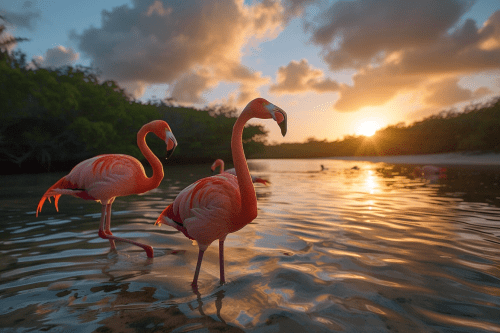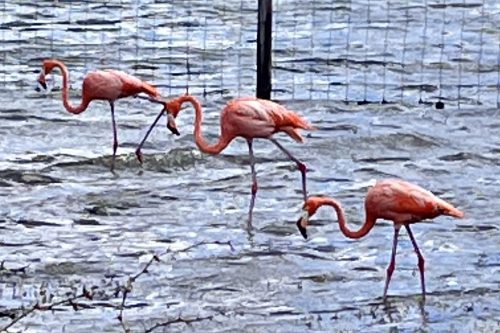Bonaire flamingos: a pink paradise revealed
Bonaire’s salt flats provide ideal habitat for the vibrant Caribbean flamingos. Their pink coloration occurs from their diet. The flamingos, which live in large groups and adopt a monogamous breeding strategy, are threatened by human activities. Conservation efforts, including making infrastructure safer and promoting environmentally friendly tourism, are crucial to the preservation of these iconic birds on Bonaire.
Welcome to Bonaire’s pink paradise with the largest birds on the island. Bonaire’s flamingo population is large and they can be found all over the island. Flamingos symbolize resilience and beauty and embody the spirit of this peaceful island. In this blog, we take you on a journey to discover Bonaire’s majestic flamingos. These iconic birds capture the wonder of nature.
Bonaire’s majestic flamingos
Within the island’s unique ecosystem are the salt pans. These salt pans serve as the perfect backdrop for the Caribbean flamingo. In fact, the birds bring a burst of color to Bonaire’s serene landscapes.
The Caribbean flamingo creates an enchanting spectacle that attracts nature lovers and photographers from all over the world. As you watch these animals balance gracefully on one leg, you witness a remarkable natural strategy to maintain warmth.
As you dive deeper into the lives of flamingos, you will see that they are highly social birds. They often live in large groups to protect themselves from predators. Also to be able to forage more efficiently. Or in other words, the regular search and finding of food. With their strong but elegant legs they can wade to deeper waters. In those deeper waters they stomp in the mud to extract food and pick it up with their beaks.
If you want to contribute to the conservation of flamingos, it is important to respect their habitat. This means keeping a safe distance when observing the birds. This ensures that their natural behavior is not disturbed by human presence.

A nesting site
Dive deeper into Bonaire’s nature reserves and you’ll discover that it’s not just the climate or landscape that makes this island so special to flamingos. In fact, Bonaire offers one of the few reserves where flamingos can successfully breed. A flamingo is a monogamous animal. This means that they have only one life partner with whom they have several eggs. A flamingo is sexually mature after 5 or 6 years and will have one nest per year with one egg, sometimes two.
When the breeding season arrives, a special mating dance begins. During this dance, they all turn their heads from right to left and stretch their wings to impress. When the male and female have found each other, they build a nest of clay. The flamingo lays 1 or 2 eggs, which they then incubate together.
Bonaire’s Brine Lake Flamingo Sanctuary is one of the few places on earth where flamingos can breed in peace and safety. People interested in supporting flamingo conservation can get involved with organizations that protect Bonaire’s natural habitat.
A dance of nature: food and migration
Have you ever wondered why flamingos are pink? The secret is in their diet, which is rich in carotenoids. These carotenoids are found in algae and small crustaceans and turn their feathers into vibrant shades of pink.
During the breeding season, Bonaire is short of food for the flamingo. Therefore, these birds take a daily trip to Venezuela during this period. Here the flamingos can fill their bellies in two nature reserves. This migration is a spectacle and can be viewed at Pink Beach. It also highlights the adaptability of the flamingos and the need for cross-border conservation efforts.
Daily, the flamingos go in search of algae and small crustaceans. In the salt water of Brine Lake, but also outside it in low water, the flamingos can often be found. They are not only a feast for the eyes, but also participants in one of nature’s most intricate dances. Which involves searching for food over and over again.
For flamingos and other migratory birds to have all the resources they need to survive, habitat protection is needed. Not only on Bonaire, but also along the migration routes. In this, supporting organizations dedicated to this is crucial.

Facing the dangers
Due to the growth of human activities on the island, the flamingo population is threatened. On Bonaire, for example, power lines are still held aloft with poles. To the flamingo, these power lines are invisible against the sky. This sometimes leads to fatal collisions. Meanwhile, oil exploration and extraction in nearby areas also threatens to pollute their pristine habitat. This endangers the flamingos’ food sources and breeding grounds.
These dangers demonstrate the importance of conservation to ensure the survival of these beautiful birds. By choosing renewable energy sources, for example, we can help reduce environmental threats. Reducing our dependence on fossil fuels and supporting renewable energy initiatives can also have a major impact on wildlife habitat conservation.
Conservation of Bonaire flamingos
Efforts to protect Bonaire’s flamingos are in full swing. This shows how committed the island is to its winged inhabitants. Measures such as installing rings on power lines to prevent collisions are making a difference. This also proves that sometimes human intervention can have a positive impact on nature. Creating protected areas free of construction and pollution is also a good solution. This has already produced promising results for the flamingo population.
Eco-friendly tourism is a tangible way for individuals to contribute to nature conservation. When visiting Bonaire or similar natural areas, choose activities and providers that prioritize the environment and support local conservation projects. Your choices as a tourist can have a major impact on the health of local ecosystems and the animals that depend on them.

As we conclude our journey through the world of Bonaire’s flamingos, it is clear that these birds are more than just a symbol of natural beauty. These birds flourish in the island’s salt flats and are known for their social nature. The flamingos breed successfully in Bonaire’s special reserves. Their pink color and their annual migration to Venezuela highlight the need for transboundary protection. Unfortunately, human activities threaten their existence. Efforts to protect the flamingos demonstrate Bonaire’s commitment to conservation. It sets a good example and is essential for the survival of these beautiful birds.